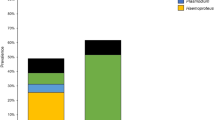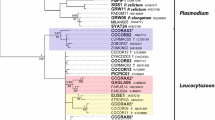Abstract
A total of 86 adult bluethroats (Luscinia svecica) from nine different localities, covering the full length of the Fennoscandian mountain range, were screened for blood parasites of the three genera Haemoproteus, Plasmodium and Leucocytozoon using a recently developed polymerase chain reaction method. The overall occurrence of infection was 59.3%. Prevalence of Leucocytozoon spp. (47.7%), Plasmodium spp. (23.3%) and Haemoproteus spp. (1.2%) was detected. Of the infected birds, 15.1% carried mixed infections. Five different mitochondrial DNA-lineages of Leucocytozoon spp., eight lineages of Plasmodium spp. and one lineage of Haemoproteus spp. were found. Due to large sequence divergence these corresponded to at least five different species, but with the possibility of all 14 being independent evolutionary units with the potential of evolving different effects on the host. Of the lineages of Leucocytozoon spp., the most common was found throughout the range. The occurrence of the second most common lineage of Leucocytozoon spp. showed significant variation in prevalence between sites. The data also showed molecular evidence of one lineage of Leucocytozoon sp. existing in more than one species of avian host, thus challenging the use of host taxon as a taxonomic character when distinguishing between different species leucocytozoids.


Similar content being viewed by others
References
Adlard RD, Peirce MA, Lederer R (2002) New species of Leucocytozoon from the avian families Otidae, Podargidae and Threskiornithidae. J Nat Hist 36:1261–1267
Atkinson CT, Van Riper III C (1991) Pathogenicity and epizootiology of avian haematozoa: Plasmodium, Leucocytozoon, and Haemoproteus. In: Loye JT, Zuk M (eds) Bird-parasite interactions: ecology, evolution and behavior. Oxford University Press, Oxford, pp 19–48
Bensch S, Stjernman M, Hasselquist D, Östman Ö, Hansson B, Westerdahl H, Pinheiro RT (2000) Host specificity in avian blood parasites: a study of Plasmodium and Haemoproteus mitochondrial DNA amplified from birds. Proc R Soc Lond B 267:1583–1589
Bensch S, Perez-Triss J, Waldenström J, Hellgren O (2004) Linkage between nuclear and mitochondrial DNA sequences in avian malaria parasites – multiple cases of cryptic speciation? Evolution (in press)
Cramp S (ed) (1988) The birds of western Palearctic, vol 5. Oxford University Press, Oxford.
Desser SS, Bennett GF (1993) The genera Leucocytozoon, Haemoproteus and Hepatocystis. In: Kreier JP (ed) Parasitc protozoa, vol 4. Academic Press, San Diego, pp 273–307
Deviche P, Greiner EC, Manteca X (2001) Seasonal and age-related changes in blood parasite prevalence in dark-eyed juncos (Junco hyemalis, Aves, Passeriformes). J Exp Zool 289:456–466
Escalante AA, Freeland DE, Collins WE, Lal AA (1998) The evolution of primate malaria parasites based on the gene encoding cytochrome b from the linear mitochondrial genome. Proc Natl Acad Sci USA 95:8124–8129
Fallis MA, Desser, SS (1977) On species of Leucocytozoon,Haemoproteus and Hepatocystis. In: Kreier JP (ed) Parasitic protozoa, vol 3. Academic Press, New York, pp 239–266
Hall TA (1999) BioEdit: a user-friendly biological sequence alignment editor v. 5.0.9. Nucl Acids Symp Ser 41:95-98
Hellgren O, Waldenström J, Bensch S (2004) A new PCR assay for simultaneous studies of Leucocytozoon, Plasmodium and Haemoproteus from avian blood. J Parasitol (in press)
Hey J, Waples, RS, Arnold ML, Butlin RK, Harrisson RG (2003) Understanding and confronting species uncertainty in biology and conservation. Trends Ecol Evol 18:597–603
Kumar S, Koichiro T, Jacobsen IB, Nei M (2001) MEGA2: molecular evolutionary genetics analysis software. Bioinformation 17:1244–1245
Malmqvist B (1994) Preimaginal blackflies (Diptera, Simuliidae) and their predators in a central Scandinavian lake outlet stream. Ann Zool Fenn 31:245–255
Malmqvist B (1999) Life history of Metacnephia lyra, a blackfly highly characteristic of large Swedish river rapids at the time of maximum discharge (Diptera : Simuliidae). Aquat Insects 2:1 89–98
Malmqvist B, Zhang YX, Adler P H (1999) Diversity, distribution and larval habitats of north Swedish blackflies (Diptera : Simuliidae). Freshw Biol 42:301–314
Malmqvist B, Strasevicius D, Hellgren O, Adler PH, Bensch S (2004) Vertebrate host specificity of wild-caught blackflies revealed by mitochondrial DNA in blood. Proc R Soc Lond B 271:152–155
Ojanen U, Ratti O, Adler PH, Kuusela K, Malmqvist B, Helle P (2002). Blood feeding by black flies (Diptera: Simuliidae) on black grouse (Tetrao tetrix) in Finland. Entomol Fenn 13:153–158
Peirce MA, (1981) Distribution and host-parasite check-list of the haematozoa of birds in West Europe. J Nat Hist 15:419–458
Perkins SL, Osgood SM, Schall JJ (1998) Use of PCR for detection of subpatent infections of lizard malaria: implications for epizootiology. Mol Ecol 7:1587–1590
Richard FA, Sehgal RNM, Jones HI, Smith TB (2002) A comparative analysis of PCR-based detection methods for avian malaria. J Parasitol 88:819–822
Riche TL (1988) Interaction between malaria parasites infecting the same vertebrate host. Parasitology 96:607–639
Rintamäki PT, Ojanen W, Pakkala H, Tynjälä M (1998) Blood parasites of migrating willow warblers (Phylloscopus trochilus) at a stopover site. Can J Zool 76:984–988
Rintamaki PT, Huhta E, Jokimaki J, Squires-Parsons D (1999) Leucocytozoonosis and trypanosomiasis in redstarts in Finland. J Wildl Dis 35:603–607
Sambrook J, Fritch FJ, Maniatis T (2002) Molecular cloning, a labaratory manual. Cold Spring Harbor Laboratory Press, Cold Spring Harbor, N.Y.
Valkiûnas G (1997) Bird haemosporida. Institute of Ecology, Vilnius, Lithuania
Valkiûnas G, Ashford RW (2002) Natural host range is not a valid taxonomic character. Trends Parasitol 18:528–529
Valkiûnas G, Iezhova TA, Shapoval AP (2003) High prevalence of blood parasites in hawfinch Coccothraustes coccothraustes . J Nat Hist 37:2647–2652
Waldenström J, Bensch S, Kiboi S, Hasselquist D, Ottosson U (2002) Cross-species infection of blood parasites between resident and migratory songbirds in Africa. Mol Ecol 11:1545–1554
Waldenström J, Hasselquist D, Bensch S, Östman Ö. (2004) A new nested polymerase chain reaction method very efficient in detecting Haemoproteus and Plasmodium infections from avian blood. J Parasitol 90:191–194
Acknowledgements
The study was supported by grants from Stiftelsen Lunds Djurskyddsfond and Olle och Signild Engkvist Stiftelser. Thanks to Charlotte Valind for excellent help during the sampling trip, Åke Lindström for making the field trip possible, and Kjell Grimsby, Thomas Holmberg, Trond Amundsen and Nils-Åke Andersson for help during the field season. I thank Dennis Hasselquist for scientific input. Staffan Bensch and Jonas Waldenström provided insightful comments on the manuscript.
Author information
Authors and Affiliations
Corresponding author
Additional information
Communicated by F. Bairlein
Rights and permissions
About this article
Cite this article
Hellgren, O. The occurrence of haemosporidian parasites in the Fennoscandian bluethroat (Luscinia svecica) population. J Ornithol 146, 55–60 (2005). https://doi.org/10.1007/s10336-004-0055-4
Received:
Revised:
Accepted:
Published:
Issue Date:
DOI: https://doi.org/10.1007/s10336-004-0055-4




